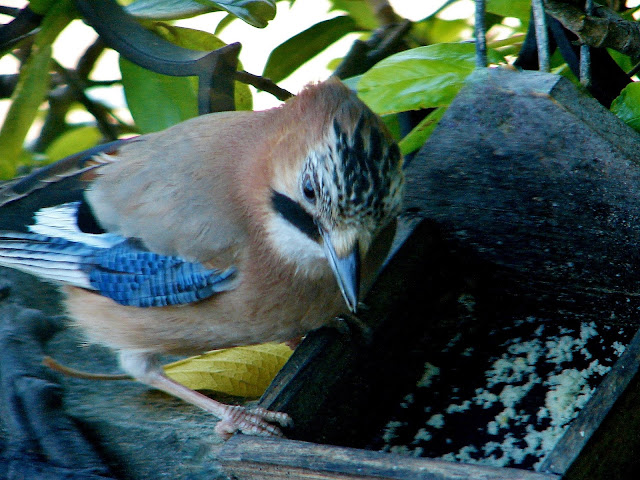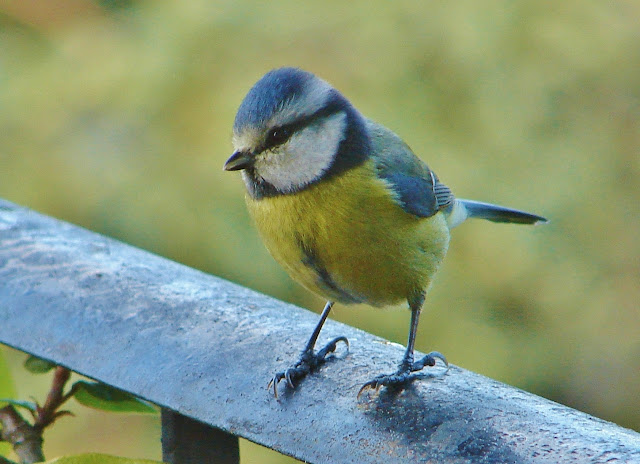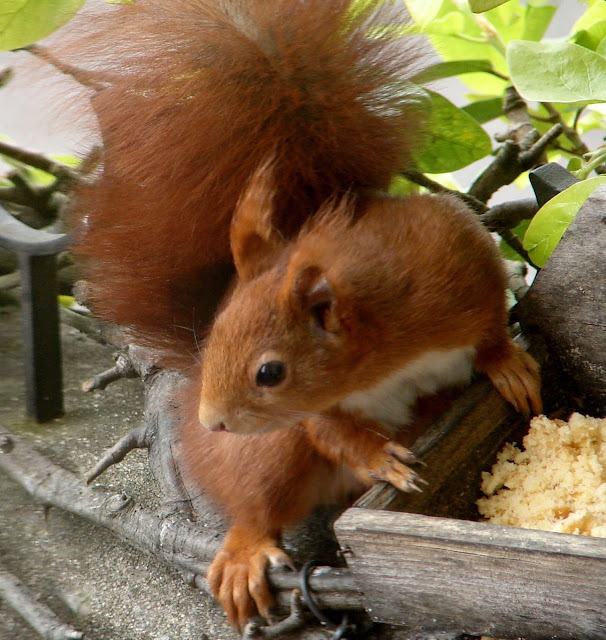In my last post, I shared pictures of the Pyracantha hedge, and I remember when the individual shrubs were first planted, all in a row, set at 75 cm intervals in front of our garage. They didn't look as though they would ever join up, but because of the needle sharp spikes, they soon formed a dense hedge, and grew very tall. mine is about 2 . 50 meters, but only because it wasn't pruned this year.
I saw the sunlit trees on top of the mountain and took this photo as I walked down to see what I could find in the hedge which was in shade. The garage is to the right of the hedge and the sloping field to the left. It was on one of these visits, I noticed the shrub at the end of the row looked stunted. The leaves were small, and it hadn't grown as tall as the other plants.
On inspection I found that it had a thick covering of ivy, and it had smothered the whole stem. so I started to untangle the many layers, and it was after I had uncovered the shrub, and found it had just a stump at the top, that I stood there in amazement, it took me several seconds for my brain to kick into gear., for it was not a malformed stump, with a kind of knob at the top, but a living creature..
It was a large slug, I mean really huge, larger than I had ever seen before, and now that it had been disturbed from the cool place under the ivy, it had to remove itself from the heat of the sun., and it started to unwind very slowly from its perch. I was not in the least repulsed by the Slug, or the trail of slime, but absolutely fascinated. by the gliding movements it made. It was a slow decent.,but I had plenty of time to spare. I think it's the first time, I have ever really looked at a slug in detail.
The bottom side of a slug, which is flat, is called the 'foot'. Like almost all gastropods, a slug moves by rhythmic waves of muscular contraction on the underside of its foot. It simultaneously secretes a layer of mucus that it travels on, which helps prevent damage to the foot tissues., and the slime is essential to keep slugs soft bodies from drying out. Around the edge of the foot in some slugs is a structure called the 'foot fringe', which you can see on this one.
Most slugs evolved from snails, losing all or part of their shell over time.The word slug, or land slug, is a common name for any apparently shell-less terrestrial gastropod mollusc., Generally disliked by farmers and gardeners, but while they can be a pest, they can also be beneficial, and even have a role to play in your garden,
The majority of land slugs have two pairs of 'feelers' or tentacles on their head. The upper pair is light sensing and has eye spots at the ends, while the lower pair provides the sense of smell. Both pairs are retractable..Seen best in the first and second image.
I didn't see much damage to the leaves caused by the Slug, and I believe the stunted growth was mainly caused by the lack of sunshine, as Pyracantha plants like sunny locations, and it had not seen the light of day for who knows how long, being covered by the Ivy, but of course the slug had eaten leaves and stems from the trunk, and it's interesting to know that slugs are aided in consuming plants, and other food sources, by their teeth!
They have 27,000 of them!! Slugs have so many teeth because they do not chew before swallowing. Instead their food is passed by a ribbon - like band of microscopic teeth, which is known as a Radula. The Radula acts like a circular saw which cuts through the vegetation, and other things it eats. When the Radula wear out, new teeth move forward to replace them.
In addition to eating living plant material, slugs eat a wide variety of other things, such as decaying matter,and plant debris, playing an important role in nutrient recycling, and the slime it produces which is considered repulsive by many people, has substances used in the production of beauty products, which is beneficial to the skin.
Slugs are hermaphrodites, and lay their many eggs underground, and this happens three times a year. It takes about a year for slugs to mature into adults, and once they reach adulthood, slugs live for just a couple of years. Looking at this image, I can't help but see the beauty in it's appearance.
Rather than a singular structure, that could be described as a brain, slugs have ganglia, or "Knots of nerves" located around the body. These form a nerve network.
I could not photograph all the length of the body, but as it headed downwards towards the ground, I knew it would find more Ivy to hide underneath, away from it's predators such as Toads, Snakes, Thrushes, Blackbirds, Squirrels, Hedgehogs and Foxes to name a few.
I will end this post as I started by sharing more images of the hedge. It is now bent down with the weight of the red berries, and so brightly coloured that these photos do not do it justice.. It will only be pruned with shears next year, from May / July.
With closer images you can see the beauty of this hardy shrub.. You can take semi-hard cuttings with a heel from July/ September, so there is still time to do this in mild weather, and either train it against a wall, make a shrub,or hedge.
Aphids are it's main problem, as they eat the young shoots, so that is why it attracts so many insects to gorge on the green aphids, and it gave me plenty of opportunities to photograph lots of different species.
I hope you will forgive me for indulging myself with another very long post. I seem to have got carried away again...































































